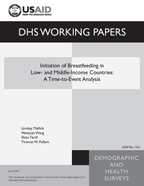- PUBLICATIONS
- JOURNAL ARTICLES
- ORDER PUBLICATIONS
Publications Summary
- Document Type
- Working Papers
- Publication Topic(s)
- Maternal Health, Nutrition
- Country(s)
- Albania, Armenia, Egypt, Jordan, Maldives, Tajikistan, Bangladesh, Cambodia, India, Indonesia, Myanmar, Nepal, Pakistan, Philippines, Timor-Leste, Angola, Benin, Burundi, Chad, Ethiopia, Ghana, Kenya, Lesotho, Malawi, Senegal, South Africa, Tanzania, Uganda, Zimbabwe, Guatemala, Haiti
- Language
- English
- Recommended Citation
- Mallick, Lindsay, Wenjuan Wang, Shiza Farid, and Thomas W. Pullum. 2020. Initiation of Breastfeeding in Low- and Middle-Income Countries: A Time-to-Event Analysis. DHS Working Paper No. 163. Rockville, Maryland, USA: ICF.
- Download Citation
- RIS format / Text format / Endnote format
- Publication Date
- June 2020
- Publication ID
- WP163
Download
 Initiation of Breastfeeding in Low- and Middle-Income Countries: A Time-to-Event Analysis (PDF, 1216K)
Initiation of Breastfeeding in Low- and Middle-Income Countries: A Time-to-Event Analysis (PDF, 1216K)
Download this publication
There is no printed copy available to order.
